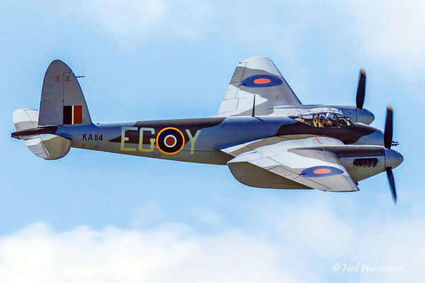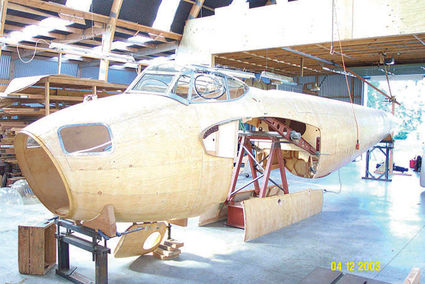Where there's a will, there's a way – Building a de Havilland Mosquito from scratch!
Short Flights
This restored Mosquito DH.98 was essentially built around the data plate by Glyn Powell and Mike Tunnicliff who run Mosquito Aircraft Restoration in Drury, Auckland. The first flight was Sept. 28, 2012
My dear Mother had a saying that has been with me for years – "Where there's a will – there's a way!" Glyn Powell must have lived by this saying.
The plane came to New Zealand seven years earlier, after being pulled from a Russian swamp.
The Canadian-built Mosquito KA114 was owned by American warbird enthusiast Gerald Yagen, who commissioned Glyn Powell's company to restore the bodywork. The 'Mossie' has since been sold. In 2013, Yagen began selling off his collection of WWI and WWII warbirds in Virginia Beach, VA, including the Mosquito.
The restoration project took Mr. Powell and Mr. Tunnicliffe three years, and experts at Avspecs a further four to do the metal work and fit the instruments. Although there are decades of work that occurred before Powell began this restoration.
It would have been a simpler restoration if Mosquitos were aluminum. All of the large fuselage molds, the tooling and attachment jigs had been scrapped in the early 1950s by the de Havilland Company. Glyn Powell had a strong will and his business through the years was rebuilding Mosquitoes, so he began making the fuselage molds and jigs from original blueprints and measurements from other Mosquitoes.
The Mosquito's fuselage was constructed in two halves (like a giant model airplane), with each half being made up of a birch and balsa ply formed and shaped on a mahogany or concrete mold. Subsequently both halves were glued and screwed together to form a remarkably strong monocoque fuselage.
The mahogany forms then have the balsa ply laid onto the mold. After the two molds are completed, they are fitted together. Photos from Mosquito Aircraft Restoration
This photo shows the two fuselage pieces fitted together. The process from molds to fitting together took two and a half years! Very slow process – a true labor of love.
As explained before, the Mosquito has a wooden construction: fuselage, wing etc., which was held together with screws and glue. Both wood and glued joints have a relatively short lifespan: both are severely affected by climate and have a natural longevity. The glue originally used in the Mosquito's construction was a compound based on a phosphoprotein called Casein, a by-product of the dairy industry. It had a low resistance to moisture, fungi and climatic changes. The plywood would delaminate when the glue was exposed to climates in the Mediterranean and the Far East. Powell used newer resins on this restoration and it will last for decades.
The de Havilland Mosquito was planned as a fast twin-engine fighter-bomber. In fact it proved a success in a variety of roles, including fighter, bomber, photo-reconnaissance, night-fighter, anti-shipping and submarine, transport and it was even adapted for use with a smaller variant of the "bouncing bomb", made famous by the "Dambusters" raid, called Highball.
It was operated by a crew of two and was powered by two Rolls-Royce Merlin engines. It was armed with four .303 Browning machine guns in its nose, four centrally-located 20mm Hispano cannon in the fuselage belly and could carry a payload of 4000 pounds. The FB (Fighter Bomber) Mk. XVIII was fitted with a Molins "6 pounder" cannon – a modified 57mm anti-tank gun, fitted with an autoload mechanism.
It was referred to by the Luftwaffe as, "The Timber Terror". The world's first true multi-role combat aircraft had arrived and it entered full service with the Royal Air Force in 1942 as one of the fastest operational aircraft in the world.
For more information with photos and videos, go to: http://www.mossie.org/NZ2308.htm photos of jigs and progress, http://www.tank-net.com/forums/index.php?showtopic=37411 Mossie flying with Spitfire and Vampire.
See you on our next flight!






